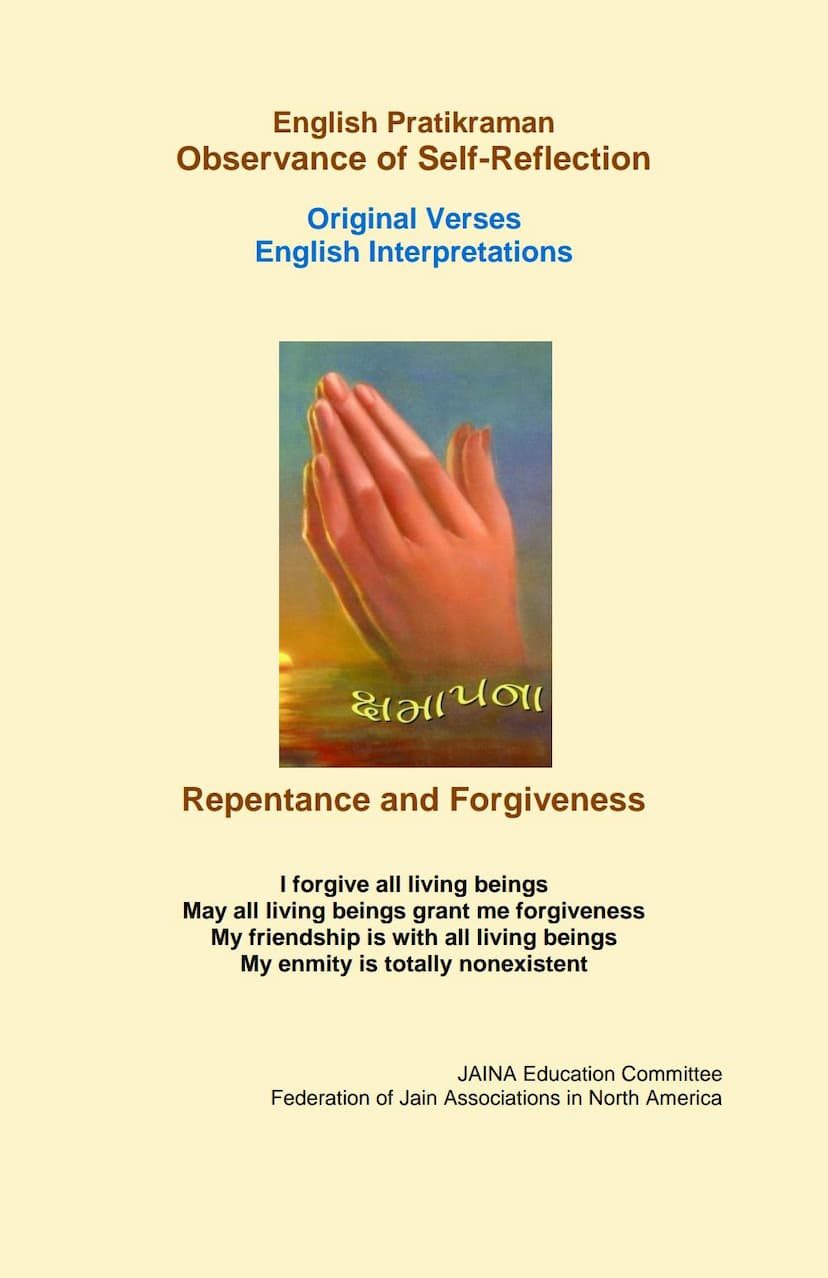JES 931 English Pratikramana Color E6
Added to library: September 1, 2025

Summary
This document, "$JES 931 English Pratikraman Color E6" published by the JAINA Education Committee, provides an English interpretation and guide to the Jain Pratikraman ritual, a significant observance of self-reflection and repentance. Authored by Pravin K. Shah, this book aims to make the complex Pratikraman ritual accessible to the English-speaking Jain community, particularly in the Western world.
Core Concept of Pratikraman:
Pratikraman, in Jainism, is a ritual of introspection, repentance, confession of sins, and seeking forgiveness. It is considered the fourth of the six essential daily practices (Avashyaka) for Jains, aimed at removing soul impurities like ignorance (Mithyätva) and passions (Kashäyas - anger, ego, deceit, greed). The ultimate goal is spiritual progress and liberation (Moksha).
The Six Avashyakas (Essential Practices):
The book details the six essential practices that are often integrated into the broader Pratikraman ritual:
- Sämäyika: Achieving a state of equanimity, detached from worldly activities, for a prescribed duration (minimum 48 minutes for lay people). It involves controlling mind, speech, and body, and meditating on the true nature of the soul.
- Chaturvimshati-Stava: Devotional prayer and worship of the 24 Tirthankaras, acknowledging their qualities and virtues.
- Vandanā: Showing respect and bowing to ascetics (Āchāryas, Upādhyāyas, Sādhus, Sādhvis).
- Pratikraman: The core act of repentance and confession for minor violations of vows committed knowingly or unknowingly, and extending forgiveness to others.
- Kāyotsarga: Meditation in a motionless posture to develop non-attachment to the body and purify the soul.
- Pratyakhyana or Pachchakhana: Taking religious vows for self-improvement, spiritual growth, or specific day-to-day commitments.
The Pratikraman Ritual Structure:
The book outlines the Pratikraman ritual in a structured manner, emphasizing the "six Essentials" (Avashyaka).
- Part 1: Adoption of Sämäyika: This involves reciting prayers like the Namaskär Mahämangal Sutra (Pancha Paramesthi Mantra), the Chattäri Mangalam Sutra (Benedictory Verse), and the Panchindiya Sutra (Guru Sthäpanä), followed by the Iryä Vahiyae Sutra for repentance of sins related to movement and the Käyotsarga and Karemi Bhante Sutras to solidify the vow of Sämäyika.
- Part 2: Praying to 24 Tirthankars: Recitation of sutras like Logassa, Namutthunam, and Jaya Viyaräya Sutras to praise and connect with the Tirthankaras.
- Part 3: Respecting Ascetics (Vandana): Includes sutras like Ichchhami Khamasamaṇo, Icchakāra sutra, Abbhutthio Sutra, and Tikhutto Sutra to show respect and seek forgiveness from ascetics.
- Part 4: Repentance and Forgiveness (Pratikraman): This section details the core repentance with sutras like Samvatsaria Padikkamane Thäum?, Säta Läkha Sutra (acknowledging 8.4 million life forms), and the 18 Päpsthänak Sutra (18 categories of sins). It also includes reflection on Atichär (minor violations) of the 12 vows of laypeople and general atonement. The crucial Khämemi Savve Jiva Sutra is recited for universal forgiveness.
- Part 5: Käyotsarga: Further meditation, often with the Arihanta-ceiyänam and Annattha Sutras, to reinforce self-discipline and detachment.
- Part 6: Religious Vows (Pratyakhyana): The individual takes specific vows for personal improvement, spiritual goals, or daily conduct.
- Part 7: Reflections: Concluding prayers and songs focusing on the true teacher (Sadguru), universal peace, universal friendship (Maitri Bhävanä), and spirituality.
- Part 8: Conclusion of Sämäyika: The Sämäyika vow is concluded with the Sämäiya-Vayajutto Sutra and Guru Utthäpanä, followed by the Namaskär Sutra.
Key Themes and Preparations:
- Importance of Ritual: The book emphasizes that Jain rituals involve both physical postures (Kriyā Yoga - Āsana Yoga, Varna Yoga) and internal reflection (Jnāna Yoga - Artha Yoga, Älambana Yoga, Nirälambana Yoga) for spiritual benefit.
- Paryushan and Das Lakshana Parva: It explains these important annual festivals of repentance and spiritual purification, highlighting their significance for shedding karma and self-realization.
- No-Copyright and Respectful Use: The book is marked as having no copyright for private, personal, and non-commercial use, with a strong emphasis on using the religious material respectfully.
- Dedication: Dedicated to people committed to compassionate living, promoting nonviolence, environmental protection, and interdependence. It specifically commends vegan and alcohol/drug-free lifestyles as stemming from an ethical value system.
- Preparation: Rules for preparation include wearing clean clothes, using a Charavalo (broom) for sweeping, sitting on a cotton cloth, and covering the mouth with a Muhapatti to minimize violence.
- Muhapatti Significance: The Muhapatti (handkerchief) is described as a symbol of purity and protection against unseen life forms, with specific rituals for inspecting and wearing it.
- 12 Vows of Laypeople: The appendix details the five main vows (Anuvratas), three merit vows (Guna-vratas), and four disciplinary vows (Shikshä-vratas) that lay Jains are encouraged to follow.
- 108 Attributes: It lists the 108 attributes of the five supreme beings (Pancha Paramesthis), explaining their significance and connection to the Jain rosary (Mala).
- Inspiration: The book includes poems like "Believe In Yourself" and "Slow Dance," along with spiritual reflections, to inspire readers towards a more mindful and compassionate life.
In essence, "English Pratikraman" serves as a practical guide for Jains to engage in the Pratikraman ritual, understanding its underlying philosophy, the meaning of its prayers and verses, and its role in their spiritual journey towards self-purification and liberation.